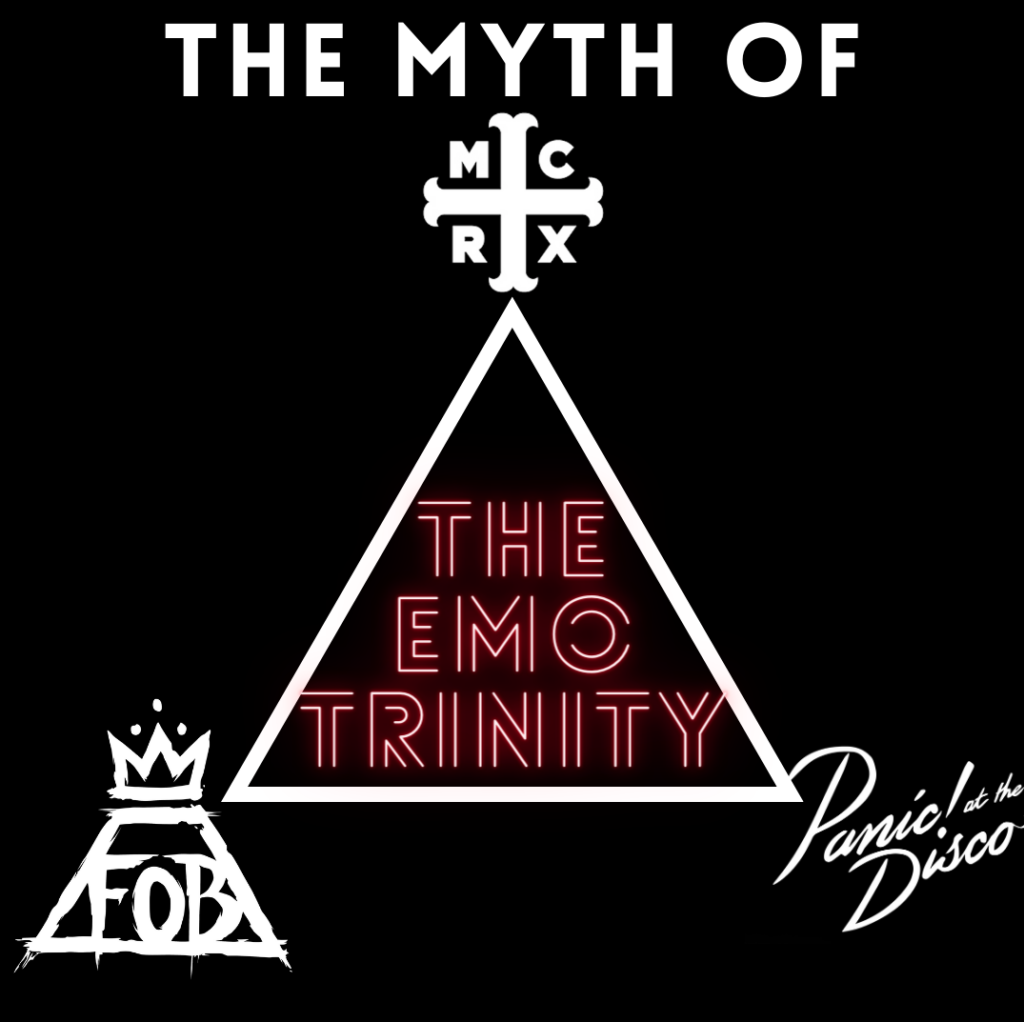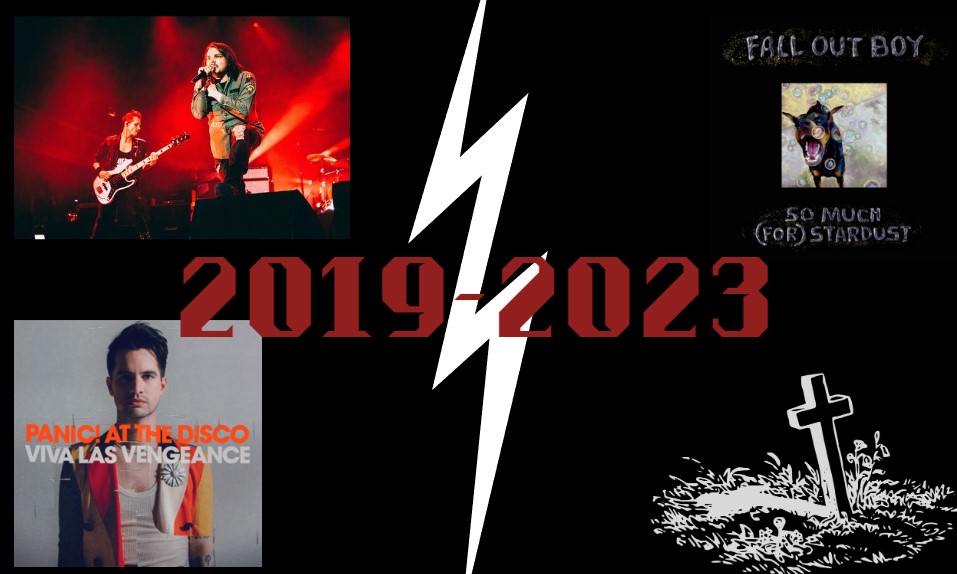
The Emo Trinity is usually a reference to the collection of three of the most famous and influential emo bands of the 2000s and 2010s: Fall Out Boy, Panic! at the Disco, and My Chemical Romance.
There is a famous theory that all three cannot exist at once, meaning that at most points throughout the bands’ collective history, at least of them has been on hiatus or broken up.
Let’s test that theory, shall we?
To begin, we must establish the timelines for each individual band, starting with Fall Out Boy.
Fall Out Boy was formed in 2001 in Chicago, Illinois. They were active from 2001-2009, then went on hiatus until 2013, and are still active today.
My Chemical Romance was formed in Newark, New Jersey, also in 2001. They were active from 2001-2013, when they formally broke up. However, the band made a comeback in 2019, and are still active today.
Panic! at the Disco was formed in 2004 in Las Vegas, Nevada, and were consistently active until the band was officially disbanded this year,.
Already, it seems like Panic! being consistently active for 19 years throws a wrench in this theory.
Based on this information, the periods when all three bands were together are as follows:
2004-2009
2019-2023
These periods definitely stick out to me as incredibly important periods in the history of these bands.

From 2004-2009, the bands were putting out what is now widely considered to be their best music.
For FOB, they released From Under the Cork Tree, Infinity on High, and Folie à Deux. Personally, Folie is my favorite FOB album that they’ve ever released.
Panic! put out their first two studio albums, A Fever You Can’t Sweat Out and Pretty. Odd. Both of these are in my top three Panic! albums.
MCR released Three Cheers for Sweet Revenge and The Black Parade, which are their most popular albums on top of being considered some of their best work.
During this period, the Emo Trinity were on the top of their game, and the emo genre was booming in popularity. Other famous emo records from the era include Paramore’s Riot!, The Used’s In Love and Death, and Mayday Parade’s A Lesson in Romantics.

Next, we have the period of 2019-2023, which sticks out to me for exactly the opposite reason: these bands were hardly releasing any music. MCR hasn’t released any music since before they broke up in 2013, and FB and Panic! have only released one record each.
As for those records that were released during this period, it didn’t receive nearly the same attention and praise as the previous period.
Take Panic! at the Disco’s 2022 album, Viva Las Vengeance. While music critics have given it positive reviews, many fans felt disappointed and bored by the album.
To be fair to Panic! in this case, there was a large faction of fans (me included) that were just waiting for the band to finally die, when Brendon Urie was the only surviving member. To read more about that, check out my post on Panic!’s downfall, linked here.
Now, what about FOB’s newest release, So Much (for) Stardust? The album didn’t receive much critical attention, but the band’s fanbase was excited to have new music after 5 years without an album.
PS – don’t worry, my review of So Much (for) Stardust is coming soon! Keep your eyes peeled in the coming weeks!
So why was the second period so much less successful than the first?
There’s a lot of reasons for that, most importantly being simple timing. At this point, most of the band members are well into their 40s and have families to balance along with their careers.
While emo is certainly back with a vengeance, the trends that allowed emo to thrive in the mid-2000s have not all carried over. Despite nostalgia culture going strong, the trends encompassing our current culture embody multiple different decades all at once – most prominantly 70s, 90s, and 2000s right now.
2000s culture is sharing the trend stage with current competing trends as well, an issue that the 2004-2009 era did not have.
Despite the overall emo culture being able to thrive in its niche community today, it still struggles to strive in the mainstream in the manner that it did in earlier decades.
So, we circle back to the Emo Trinity theory: why does it seem that they rarely exist all at once?
As we’ve pointed out, the three bands have shared the pop culture stage with one another, so it’s not impossible for them to exist all at once. Obviously, that statement is usually made in jest, but the point still stands.
However, the fact that the bands’ individual timelines line up in such a way does suggest some more interesting patterns within the emo scene.
The most obvious answer to this roundabout question seems to be competition, but I think it goes deeper than that as well.
Sure it would be difficult for three bands of a similar genre and demographic makeup to share a mainstream spotlight in the manner that all of these bands did at one point or another. The fact that they’re all made up of primarily white men of a similar age making music in the same genre, all with similar influences certainly doesn’t help the competition aspect either.
When emo was reaching a peak in popularity from 2004-2009, there was plenty of room for all three bands to coexist – and make plenty of money while doing so.
Conversely, emo may be back nowadays with a vengeance, but the bands of the Emo Trinity aren’t necessarily gaining new members the way that they were back during the height of 2000s emo. Rather, the next generation of emos are growing up on a mixture of new and old emo groups.
So what should we take away from this?
Is the myth of the Emo Trinity just a silly little tidbit spread to make a broad generalization about the bands and generate hype?
Sort of.
It’s also a statement about the music industry and the difficulties of competition in between artists in similar genres.
It’s also a statement about how the music industry treats older acts, both in terms of the age of the musicians and how long they’ve been in the scene.
So, in short, when my friends and I used to say these bands were “too powerful to exist all at once,” we weren’t totally wrong.
Sure, we were totally just being silly and worshipping these bands for their starpower, but we had also found a little nugget of truth about the music industry, unbeknownst to us.
If this one got you missing the music from the Emo Trinity’s Golden Age (that 2004-2009 period really was the best) then check out the Listen for Yourself tab, where you can find my curated playlist full of some of the best songs from that period.
Don’t forget to share this post if you enjoyed it! Thanks so much for reading, if you got this far!!